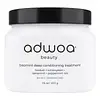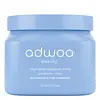What's inside
What's inside
 Key Ingredients
Key Ingredients

No key ingredients
 Benefits
Benefits

 Concerns
Concerns

 Ingredients Side-by-side
Ingredients Side-by-side

Water
Skin ConditioningButyrospermum Parkii Butter
Skin ConditioningCocos Nucifera Oil
MaskingBehentrimonium Methosulfate
Cetearyl Alcohol
EmollientCetyl Alcohol
EmollientGlycerin
HumectantGlyceryl Stearate
EmollientAdansonia Digitata Oil
EmollientPrunus Amygdalus Dulcis Oil
Skin ConditioningOpuntia Ficus-Indica Seed Oil
EmollientCetyl Esters
EmollientHydrolyzed Wheat Protein
Skin ConditioningCetrimonium Chloride
AntimicrobialBiotin
AntiseborrhoeicGuar Hydroxypropyltrimonium Chloride
Skin ConditioningCucurbita Pepo Seed Oil
EmollientCaprylyl Glycol
EmollientPhenoxyethanol
PreservativeGaultheria Procumbens Leaf Oil
MaskingMentha Piperita Oil
MaskingMentha Viridis Leaf Oil
AstringentQuaternium-80
Lavandula Spica Herb Oil
PerfumingRosmarinus Officinalis Leaf Oil
MaskingMenthol
MaskingWater, Butyrospermum Parkii Butter, Cocos Nucifera Oil, Behentrimonium Methosulfate, Cetearyl Alcohol, Cetyl Alcohol, Glycerin, Glyceryl Stearate, Adansonia Digitata Oil, Prunus Amygdalus Dulcis Oil, Opuntia Ficus-Indica Seed Oil, Cetyl Esters, Hydrolyzed Wheat Protein, Cetrimonium Chloride, Biotin, Guar Hydroxypropyltrimonium Chloride, Cucurbita Pepo Seed Oil, Caprylyl Glycol, Phenoxyethanol, Gaultheria Procumbens Leaf Oil, Mentha Piperita Oil, Mentha Viridis Leaf Oil, Quaternium-80, Lavandula Spica Herb Oil, Rosmarinus Officinalis Leaf Oil, Menthol
Water
Skin ConditioningBehentrimonium Methosulfate
Cetearyl Alcohol
EmollientButyrospermum Parkii Butter
Skin ConditioningCetyl Alcohol
EmollientGlycerin
HumectantCetrimonium Chloride
AntimicrobialRicinus Communis Seed Oil
MaskingVitis Vinifera Seed Oil
EmollientGlyceryl Stearate
EmollientDiheptyl Succinate
EmollientCapryloyl Glycerin/Sebacic Acid Copolymer
Skin ConditioningCetyl Esters
EmollientMoroccan Lava Clay
AbrasiveCocoyl Hydrolyzed Quinoa Protein
Tanacetum Annuum Flower Oil
MaskingUlmus Davidiana Root Extract
Skin ConditioningBambusa Vulgaris Extract
Skin ConditioningParfum
MaskingMacrocystis Pyrifera Extract
Skin ConditioningEquisetum Arvense Extract
AstringentUrtica Dioica Extract
AstringentMangifera Indica Seed Butter
Skin ConditioningAdansonia Digitata Seed Oil
EmollientSimmondsia Chinensis Seed Oil
EmollientTocopheryl Acetate
AntioxidantSpirulina Platensis Powder
Skin ProtectingCaprylyl Glycol
EmollientPhenoxyethanol
PreservativeWater, Behentrimonium Methosulfate, Cetearyl Alcohol, Butyrospermum Parkii Butter, Cetyl Alcohol, Glycerin, Cetrimonium Chloride, Ricinus Communis Seed Oil, Vitis Vinifera Seed Oil, Glyceryl Stearate, Diheptyl Succinate, Capryloyl Glycerin/Sebacic Acid Copolymer, Cetyl Esters, Moroccan Lava Clay, Cocoyl Hydrolyzed Quinoa Protein, Tanacetum Annuum Flower Oil, Ulmus Davidiana Root Extract, Bambusa Vulgaris Extract, Parfum, Macrocystis Pyrifera Extract, Equisetum Arvense Extract, Urtica Dioica Extract, Mangifera Indica Seed Butter, Adansonia Digitata Seed Oil, Simmondsia Chinensis Seed Oil, Tocopheryl Acetate, Spirulina Platensis Powder, Caprylyl Glycol, Phenoxyethanol
 Reviews
Reviews

Ingredients Explained
These ingredients are found in both products.
Ingredients higher up in an ingredient list are typically present in a larger amount.
Behentrimonium Methosulfate is an ammonium salt. It is mainly used to prevent static in haircare products as a surfactant.
Surfactants have differing ends: one side is hydrophilic while the other end is hydrophobic.
Surfactants also help your cleansers remove pollutants more easily from the skin.
Learn more about Behentrimonium MethosulfateThis ingredient is also known as shea butter. It is an effective skin hydrator and emollient.
Emollients help soothe and soften your skin. It does this by creating a protective film on your skin. This barrier helps trap moisture and keeps your skin hydrated. Emollients may be effective at treating dry or itchy skin.
Shea butter is rich in antioxidants. Antioxidants help fight free-radicals, or molecules that may harm the body. It is also full of fatty acids including stearic acid and linoleic acid. These acids help replenish the skin and keep skin moisturized.
While Shea Butter has an SPF rating of about 3-4, it is not a sunscreen replacement.
Shea butter may not be fungal acne safe. We recommend speaking with a professional if you have any concerns.
Learn more about Butyrospermum Parkii ButterCaprylyl Glycol is a humectant and emollient, meaning it attracts and preserves moisture.
It is a common ingredient in many products, especially those designed to hydrate skin. The primary benefits are retaining moisture, skin softening, and promoting a healthy skin barrier.
Though Caprylyl Glycol is an alcohol derived from fatty acids, it is not the kind that can dry out skin.
This ingredient is also used as a preservative to extend the life of products. It has slight antimicrobial properties.
Learn more about Caprylyl GlycolCetearyl alcohol is a mixture of two fatty alcohols: cetyl alcohol and stearyl alcohol. It is mainly used as an emulsifier. Emulsifiers help prevent the separation of oils and products. Due to its composition, it can also be used to thicken a product or help create foam.
Cetearyl alcohol is an emollient. Emollients help soothe and hydrate the skin by trapping moisture.
Studies show Cetearyl alcohol is non-toxic and non-irritating. The FDA allows products labeled "alcohol-free" to have fatty alcohols.
This ingredient is usually derived from plant oils such as palm, vegetable, or coconut oils. There is debate on whether this ingredient will cause acne.
Due to the fatty acid base, this ingredient may not be Malassezia folliculitis safe.
Learn more about Cetearyl AlcoholThis ingredient is a preservative, antimicrobial, and emulsifier. It is often used in cosmetics for its ability to cleanse, condition, and reduce static.
Cetrimonium chloride is a quaternary ammonium salt, meaning it has a water-soluble structure.
Cetyl Alcohol is a fatty alcohol. Fatty Alcohols are most often used as an emollient or to thicken a product.
Its main roles are:
Though it has "alcohol" in the name, it is not related to denatured alcohol or ethyl alcohol.
The FDA allows products labeled "alcohol-free" to have fatty alcohols.
Learn more about Cetyl AlcoholCetyl Esters is a synthetic wax made up of mostly fatty acids and fatty alcohols. It is strcturally similar to wax taken from whales.
As an emollient, it creates a thin barrier on the skin. This barrier prevents moisture from escaping.
This ingredient may not be fungal-acne safe.
Learn more about Cetyl EstersGlycerin is already naturally found in your skin. It helps moisturize and protect your skin.
A study from 2016 found glycerin to be more effective as a humectant than AHAs and hyaluronic acid.
As a humectant, it helps the skin stay hydrated by pulling moisture to your skin. The low molecular weight of glycerin allows it to pull moisture into the deeper layers of your skin.
Hydrated skin improves your skin barrier; Your skin barrier helps protect against irritants and bacteria.
Glycerin has also been found to have antimicrobial and antiviral properties. Due to these properties, glycerin is often used in wound and burn treatments.
In cosmetics, glycerin is usually derived from plants such as soybean or palm. However, it can also be sourced from animals, such as tallow or animal fat.
This ingredient is organic, colorless, odorless, and non-toxic.
Glycerin is the name for this ingredient in American English. British English uses Glycerol/Glycerine.
Learn more about GlycerinGlyceryl Stearate is a mix of glycerin and stearic acid.
It is used to stabilize the mixing of water and oil ingredients. By preventing these ingredients from separating, it can help elongate shelf life. It can also help thicken the product's texture.
As an emollient, it helps soften skin and supports barrier-replenishing ingredients.
In cosmetics, Glyceryl Stearate is often made from vegetable oils or synthetically produced.
This ingredient may not be fungal-acne safe
Fun fact: The human body also creates Glyceryl Stearate naturally.
Learn more about Glyceryl StearatePhenoxyethanol is a preservative that has germicide, antimicrobial, and aromatic properties. Studies show that phenoxyethanol can prevent microbial growth. By itself, it has a scent that is similar to that of a rose.
It's often used in formulations along with Caprylyl Glycol to preserve the shelf life of products.
Water. It's the most common cosmetic ingredient of all. You'll usually see it at the top of ingredient lists, meaning that it makes up the largest part of the product.
So why is it so popular? Water most often acts as a solvent - this means that it helps dissolve other ingredients into the formulation.
You'll also recognize water as that liquid we all need to stay alive. If you see this, drink a glass of water. Stay hydrated!
Learn more about Water